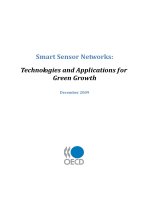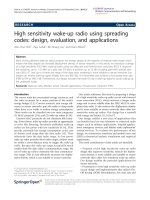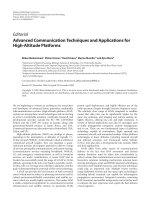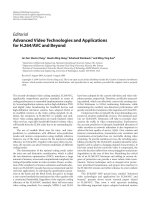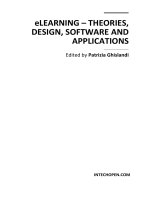reverse osmosis design, processes, and applications for engineers
Bạn đang xem bản rút gọn của tài liệu. Xem và tải ngay bản đầy đủ của tài liệu tại đây (17.22 MB, 416 trang )
This Page Intentionally Left Blank
Reverse
Osmosis
Scrivener Publishing
3
Winter Street, Suite
3
Salem, MA 01970
Scrivener Publishing Collections Editors
James
E.
R.
Couper
Rafiq Islam Pradip Khaladkar
Norman Lieberman Peter Martin
W.
Kent Muhlbauer Andrew
Y.
C. Nee
S.
A.
Sherif James
G.
Speight
Richard Erdlac
Piiblishers
at
Scriveiier
Martin Scrivener
()
Phillip Carmical
()
Reverse
Osmosis
Design, Processes, and
Applications for Engineers
Jane Kucera
Scrivener
~WILEY
Copyright
0
2010 by Scrivener Publishing
LLC.
All rights reserved.
Co-published by John Wiley
&
Sons, Inc. Hoboken, New Jersey, and Scrivener Publishing
LLC, Salem, Massachusetts
Published simultaneously in Canada
No
part
of
this publication may be reproduced, stored in
a
retrieval system,
or
transmitted in any
form
or
by any means, electronic, mechanical, photocopying, recording, scanning,
or
otherwise,
except
as
permitted under Section 107
or
108
of
the 1976 United States Copyright
Act,
without
either the prior written permission
of
the Publisher,
or
authorization through payment of the
appropriate per-copy fee to the Copyright Clearance Center, Inc.,
222
Rosewood Drive, Danvers,
MA01923, (978) 750-8400, fax (978) 750-4470,
or
on the web at uww.copyright.com. Requests to
the Publisher for permission should be addressed to the Permissions Department, John Wey
&Sons, Inc., 111 River Street, Hoboken, NJ 07030,
(201)
748-6011, fax (201) 748-6008,
or
online
at
Limit of Liability/Disclaimer of Warranty: While the publisher and author have used their
best efforts in preparing this book, they make no representations or warranties with respect
to the accuracy
or completeness of the contents
of
this book and specifically disclaim any
implied warranties
of
merchantability
or
fitness for
a
particular purpose.
No
warranty may
be created
or
extended by sales representatives
or
written sales materials, The advice and
strategies contained herein may not be suitable for your situation.
You
should consult with
a
professional where appropriate. Neither the publisher nor author shall be liable for any
loss
of
profit
or
any other commercial damages, including but not limited to special, incidental,
consequential,
or
other damages.
For general information on
our
other products and services
or
for technical support, please
contact
our
Customer Care Department within the United States at (800) 762-2974, outside the
United States at (317) 572-3993
or
fax (317) 572-4002.
Wiley
also
publishes
its
books in
a
variety
of
electronic formats. Some content that appears in
print may not be available in electronic formats.
For
more information about Wiley products,
visit
our
web site
at
www.wiley.com.
For
more information about Scrivener products please visit
wwwscrivenerpublishing.com.
Cover design by Russell Richardson
Libra
y
of
Congress
Cataloging-in-Ptrblicatiort
Data:
ISBN
978-0-470-61 8431
Printed in the United States
of
America
10 9
8
7
6
3
4
3
2
1
For
my
dad;
he’ll
always
be
O.K.
This Page Intentionally Left Blank
Contents
Preface xvii
PART
1
FUNDAMENTALS
1
Introduction and History
of
Development
3
1.1
Introduction 3
1.1.1
Uses
of
Reverse Osmosis 3
1.1.2 History of Reverse Osmosis Development 5
1.1.3 Recent Advances in RO Membrane Technology 9
1.1.4 Future Advancements 12
References 12
2
Reverse Osmosis Principles
2.1 Osmosis
2.2 Reverse Osmosis
2.3 Dead-End Filtration
2.4 Cross-Flow Filtration
3
Basic Terms and Definitions
3.1
3.2 Recovery
3.3 Rejection
3.4 Flux
3.5 Concentration Polarization
3.6 Beta
3.7 Fouling
3.8 Scaling
3.9 Silt Density Index
3.10 Langelier Saturation Index
Reverse Osmosis System Flow Rating
References
15
15
16
17
18
21
21
21
23
26
27
29
30
33
35
38
39
vii
viii
CONTENTS
4
Membranes
4.1 Transport Models
4.1.1 Solution-Diffusion Model
(non-porous model)
4.1.2 Solution
-
Diffusion Imperfection
Model (porous model)
4.1.3 Finely-Porous Model
(porous model)
4.1.4 Preferential Sorption
-
Capillary
Flow
Model (porous model)
4.1.5 Phenomenological Transport
Relationship (Irreversible
thermodynamics)
4.2.1 Cellulose Acetate
Membranes-Asymmetric
membranes
4.2.2 Polyamide and Composite
Membranes
4.2.2.1 Linear Aromatic Polyamide
4.2.2.2 Composite Polyamide Membranes
4.2.3 Improvements to Polyamide,
Composite Membranes
4.2.4 Other Membrane Materials
4.3.1 Plate and Frame Modules
4.3.2 Tubular Modules
4.3.3 Spiral Wound Modules
4.3.4 Hollow Fine Fiber Membrane
4.3.5 Other Module Configurations
4.4 Commercially-Available Membranes
4.4.1 Seawater Membranes
4.4.2 Brackish Water Membranes
4.2 Membrane Materials
Membranes
4.3 Membrane Modules
Modules
4.4.2.1 Low-Energy Membranes
4.4.2.2 High-Rejection Membranes
4.4.2.3 Low-Fouling Membranes
41
42
44
45
45
46
46
47
51
51
52
56
58
58
59
60
61
72
74
76
76
78
79
79
79
CONTENTS
ix
4.4.2.4
Low-Differential-Pressure
Membrane Modules
4.4.2.5
High-Productivity Membrane
Modules
4.4.2.6
Other Membrane/Module
TY
Pes
References
5
Basic
Flow
Patterns
5.1
Arrays
5.2
Recycle
5.3
Double Pass
5.4
Multiple Trains
6
Reverse
Osmosis
Skids
6.1
Cartridge Filters
6.2
Reverse Osmosis Feed Pumps
6.3
Pressure Vessels
6.4
Manifolding-Materials of Construction
6.5
Instrumentation
6.6
Controls
6.7
Data Acquisition and Management
6.8
Reverse Osmosis Skid
6.9
Auxiliary Equipment
6.10
Other Design Considerations
6.10.1
Access to Profile and Probe
RO
Membranes
6.10.2
Interstage Performance Monitoring
Instrumentation
6.10.3
Stage-by-Stage Membrane Cleaning
References
PART
2
PRETREATMENT
7
Water Quality Guidelines
7.1
Suspended Solids
7.2
Microbes
7.3
Organics
7.4
Color
80
81
81
83
85
85
89
90
93
95
97
100
106
114
114
116
118
120
120
121
121
121
122
122
125
125
127
128
129
X
CONTENTS
7.5
Metals
7.6
Hydrogen Sulfide
7.7
Silica
7.8
Calcium Carbonate
7.9
Trace Metals-Barium and Strontium
7.10
Chlorine
7.11
Calcium
7.12
Exposure to Other Chemicals
References
8
Techniques and Technologies
8.1
Mechanical Pretreatment
8.1.1
Clarifiers
8.1.1.1
Solids-Contact Clarifiers
8.1.1.2
Inclined-Plate Clarifiers
8.1.1.3
Sedimentation Clarifiers
8.1.1.4
Chemical Treatment for Clarifiers
8.1.2
Multimedia Pressure Filters
8.1.3
High-Efficiency Filters
8.1.4
Carbon Filters
8.1.5
Iron Filters
8.1.5.1
Manganese Greensand Filters
8.1.5.2
BIRM@ Filters
8.1.5.3
Filox Filters
8.1.5.4
Other Iron Removal Media
8.1.6
Sodium Softeners
8.1.7
Spent Resin Filters
8.1.8
Ultraviolet Irradiation
8.1.9
Membrane
8.2
Chemical Pretreatment
8.2.1
Chemical Oxidizers for Disinfection
of
Reverse Osmosis Systems
8.2.1.1
Chlorine
8.2.1.2
Ozone
8.2.1.3
Hydrogen Peroxide
8.2.2
Antiscalants
8.2.3
Sodium Metabisulfite
8.2.4
Non-Oxidizing Biocides
8.2.4.1
Sodium Bisulfite
130
131
132
134
136
136
137
139
139
141
142
142
144
145
148
149
151
153
157
160
161
162
163
163
164
167
168
169
170
171
171
176
177
177
180
182
182
CONTENTS
xi
8.2.4.2
DBNPA
8.2.4.3
Other Non-Oxidizing Biocides
8.3
Combination Mechanical Plus Chemical
Pretreatment-Lime Softening
8.3.1
Cold Lime Softening
8.3.2
Warm Lime Softening
8.3.3
Hot Process Softening
8.4
Sequencing of Pretreatment Technologies
References
PART
3
SYSTEM
DESIGN
9
Design Considerations
9.1
Feed Water Quality
9.1.1
Feed Water Source
9.1.2
Total Dissolved Solids
9.1.3
Calcium and Natural Organic Matter
9.1.4
Chemical Damage
9.2
Temperature
9.3
Pressure
9.4
Feed Water
Flow
9.5
Concentrate Flow
9.6
Beta
9.7
Recovery
9.8
pH
9.9
Flux
References
10
RO
Design and Design Software
10.1
ROSA Version
6.1
10.2
TorayDS Version
1.1.44
10.3
Hydranautics
IMS
Design Version
2008
10.4
Koch Membranes ROPRO Version
7.0
Reference
PART
4
OPERATIONS
11
On-Line Operations
11.1
Reverse Osmosis Performance Monitoring
11.2
Data Collection
11.3
Data Analysis and Normalization
182
183
183
184
185
185
187
189
193
193
193
196
197
198
198
200
201
202
202
205
207
209
209
211
214
221
224
230
234
237
237
237
239
xii CONTENTS
11.3.1
Data Normalization
11.3.1.1
Normalized Product Flow
11.3.1.2
Normalized Salt Passage
11.3.1.3
Normalized Pressure Drop
11.3.2
Normalization Software
11.4
Preventive Maintenance
References
12
Performance Degradation
12.1
Normalized Permeate Flow
12.1.1
Loss
of
Normalized Permeate Flow
12.1.1.1
Membrane Fouling
12.1.1.2
Membrane Scaling
12.1.1.3
Membrane Compaction
12.1.2
Increase in Normalized Permeate Flow
12.1.2.1
Membrane Degradation
12.1.2.2
Hardware Issues
12.2
Normalized Salt Rejection
12.2.1
Loss
of
Salt Rejection
12.2.1.1
Membrane Scaling
12.2.1.2
Membrane degradation
12.2.1.3
Hardware
Issues
12.2.2
Increase
in
Salt Rejection
12.3.1
Loss
in Pressure Drop
12.3.2
Increase in Pressure Drop
12.3
Pressure
Drop
References
13
Off-Line Operations
13.1
System Flush
13.1.1
Off-Line Flush
13.1.2
Return to Service Flush
13.1.3
Stand-by Flush
13.2.1
When to Clean
13.2.2
How to Clean
13.2.3
Cleaning Chemicals
13.2
Membrane Cleaning
13.2.3.1
High-pH cleaners
239
240
243
245
247
250
253
255
255
255
255
256
256
256
256
257
258
258
258
259
259
259
259
260
260
261
263
263
263
264
265
266
266
267
270
271
CONTENTS
13.2.3.2
Neutral-pH Cleaners
13.2.3.3
Low-pH Cleaners
13.2.3.4
Cleaners
for
Specific Foulants
and Scale
13.2.4
Cleaning Equipment
13.2.4.1
Cleaning Tank
13.2.4.2
Cleaning Recirculation Pump
13.2.4.3
Cartridge Filter
13.3
Membrane Lay-Up
13.3.1
Short-Term Lay-Up
13.3.2
Long-Term Lay-up
References
PART 5 TROUBLESHOOTING
14 Troubleshooting
14.1
Mechanical Evaluation
14.2
General Performance Issues
14.3
System Design and Performance Projections
14.3.1
System Design
14.3.2
Performance Projections
14.4
Data Assessment
14.5
Water Sampling
14.6
Membrane Integrity Testing
14.7
Profiling and Probing
14.8
Membrane Autopsy
14.8.1
Visual Inspection
14.8.2
Pressure Dye Test-Rhodamine
B
14.8.3
Methylene Blue Test
14.8.4
Fujiwara Test
14.8.5
Spectroscopy
14.8.6
Other Tests
References
PART
6
SYSTEM ENGINEERING
15 Issues Concerning System Engineering
15.1
Sodium Water Softening
15.1.1
Sequencing of the Sodium Softeners and RO
15.1.2
Sodium Softening and Antiscalants
xiii
272
273
274
274
275
277
277
277
277
278
278
283
284
285
285
285
286
287
290
29
1
291
294
295
301
301
301
302
303
304
307
307
307
309
Case
1:
High Hardness Well Water
310
xiv CONTENTS
Sodium Softener
An tiscalan
t
Summary
Case
2:
Low Hardness Surface Water
Sodium Softener
An tiscalan t
Summary
Case
3:
Well Water with Iron and Manganese
Sodium Softener
Antiscalant
15.2
Reverse Osmosis Sizing and Capacity
15.3
Membrane Cleaning: On-Site versus Off-Site
15.3.1
Off-Site Membrane Cleaning
15.3.2
On-Site Membrane Cleaning
15.4
Reverse Osmosis Reject Disposal Options
15.4.1
Discharge to Drain or Sewer
15.4.2
Discharge to
Cooling
Tower
15.4.3
Zero Liquid Discharge
References
16
Impact
of
Other Membrane Technologies
16.1
Microfiltration and Ultrafiltration
16.1.1
Microfiltration
16.1.2
Ultrafiltration
16.2
Nanofiltration
16.3
Continuous Electrodeionization
16.4
HERO Process
References
PART
7
FREQUENTLY ASKED QUESTIONS
17
Frequently Asked Questions
17.1
General
17.1.1
What is Reverse Osmosis Used for?
17.1.2
What is the Difference Between
Nanofiltration and Reverse Osmosis?
17.1.3
What is Data Normalization?
17.1.4
How
Do
SDI and Turbidity Correlate?
311
311
312
313
313
313
314
314
314
314
316
317
317
318
319
320
320
321
323
325
325
338
339
342
344
358
360
365
365
365
365
366
366
CONTENTS xv
17.1.5
Why Does the pH Drop from the RO
Feed to the RO Permeate?
366
17.2
Operational
367
17.2.1
17.2.2
17.2.3
17.2.4
17.2.5
17.2.6
17.2.7
17.2.8
17.2.9
When is it Time to Clean
an RO Membrane?
How Long Does it Take to Clean an
RO
System?
What Temperature Cleaning Solution
Should Be Used to Clean Membranes?
Can Extended Soak Time Compensate for
Cleaning at Lower Temperature, for
Example, When the Heater is
Not Working?
Should the Low or High pH Cleaning
Be Conducted First?
What Should Be Done if Cleaning Does
Not Return Performance to Baseline?
If
the Clean-In-Place Pump Cannot
Provide the Required Flow Rate, Can
the Pump Be Run at Higher Pressure
to Compensate?
What Should Be Done with Permeate that
is
Generated During Membrane Cleaning?
Why
is
the Permeate Conductivity High
After Cleaning the Membranes?
17.2.10
Why
is
Chlorine Both Added and then
17.2.11
What Chemicals Can Be Used to Disinfect
17.2.12
Why Does the RO Trip Off on Low
17.2.13
Should RO Feed Water Be Heated?
17.2.14
What Limits Recovery by an RO?
17.2.15
How
Do
I
Start up an RO?
17.2.16
Do
RO Membranes Need to Be
Preserved When Taken
Off
Line?
17.2.17
Is there
a
Shelf Life for Reverse Osmosis
Membranes?
Removed Prior to the RO?
RO Membranes Directly?
Suction Pressure?
367
367
367
368
368
368
369
369
369
369
370
370
371
371
372
372
374
xvi
CONTENTS
17.2.18 What
is
the Difference Between Membranes
that Have Been Wet Tested and those
that are Dry? 375
17.2.19 What is the Impact on the
RO
If the
Pretreatment System Fails, for
Example, If the Softener Leaks Hardness?
Be Used in an
RO
Unit?
375
376
17.3.1 What is the Footprint for an
RO
System? 377
17.3.2 What is a Variable Frequency Drive
Used for? 377
17.3.3 What
is
the Difference Between Pleated,
String-Wound, and Melt-Blown
Cartridge
Filters?
378
17.3.4 What is the Correct Way to Install Shims
and the Thrust Ring? 379
17.3.5 How should the Cleaning Pump Be Sized? 379
References 379
17.2.20 Can Different Types of Membranes
17.3 Equipment 377
Unit Equivalent and Conversions
381
Index
383
Preface
The use of reverse osmosis
(RO)
technology has grown rapidly
through the
1990's
and early
2000's.
The ability of
RO
to replace
or augment conventional ion exchange saves end users the need
to store, handle, and dispose of large amounts of acid and caus-
tic, making
RO
a "greener" technology. Additionally, costs for
membranes have declined significantly since the introduction of
interfacial composite membranes in the
1980's,
adding to the at-
tractiveness of
RO.
Membrane productivity and salt rejection have
both increased, reducing the size of
RO
systems and minimizing
the amount of post treatment necessary to achieve desired product
quality.
Unfortunately, knowledge about
RO
has not kept pace with the
growth in technology and use. Operators and others familiar with
ion exchange technology are often faced with an
RO
system with
little or no training. This has resulted in poor performance
of
RO
systems and perpetuation of misconceptions about
RO.
Much of the current literature about
RO
includes lengthy discus-
sions or focuses on a niche application that makes it difficult to find
an answer to
a
practical question or problems associated with more
common applications. Hence, my objective in writing this book is
to bring clear, concise, and practical information about
RO
to end
users, applications engineers, and consultants. In essence, the book
is a reference bringing together knowledge from other references as
well as that gained through personal experience.
The book focuses on brackish water industrial
RO,
but many
principles apply to seawater
RO
and process water as well.
xvii
This Page Intentionally Left Blank
Acknowledgements
My enthusiasm for reverse osmosis (RO) began while working
with my thesis advisor at UCLA, Professor Julius "Bud" Glater, a
pioneer who worked at UCLA with Sidney Loeb in the early days
of commercializing RO. Professor Glater was kind enough to ex-
tend a Research Assistantship to me, when my first choice was not
available. That was fortunate for me, as membrane technology is a
growing field with great future potential. Professor Glatel's guid-
ance and support were invaluable to me as a graduate student and
has continued to be throughout my career.
My knowledge grew at Bend Research, Inc. under Harry Lonsdale,
another membrane pioneer who was involved in the theoretical
and practical side of membranes since the early
1960's
at Gulf Gen-
eral Atomic (predecessor of Fluid Systems, now Koch Membrane
Systems), Alza, and later Bend Research, which he co-founded with
Richard Baker. At Bend Research,
I
had the opportunity to develop
novel membranes and membrane-based separation processes, in-
cluding leading several membrane-based projects for water recov-
ery and reuse aboard the International Space Station.
My desire to write this book was fostered by Loraine Huchler,
president
of
Mar-Tech Systems, which she founded in the mid
1990'~~
and author of the book series, Operating Practices for In-
dustrial Water Management. Loraine has provided both technical
and moral support.
Thanks also
go
to Nalco Company, Naperville, IL, for support-
ing me in this endeavor. Individuals at Nalco who have provided
technical and administrative support include: Ching Liang, Anne
Arza, Anders Hallsby, Beth Meyers, Carl Rossow, Alice Korneffel,
and Kevin OLeary. Nalco-Crossbow LLC personnel who have pro-
vided support include Mark Sadus (contributor to Chapter
6),
Scott
Watkins, Mike Antenore, Jason Fues, and Dave Weygandt.
xix
xx
ACKNOWLEDGEMENTS
Valuable technica1 support has been provided by Julius
Glater-Professor Emeritus
UCLA;
Mark Wilf of Tetratech; Rajindar
Singh-Consultant; Madalyn Epple
of
Toray Membrane
USA;
Scott
Beardsley, Craig Granlund, of Dow Water and Process Solutions;
Jonathan Wood and John Yen of Siemens Water Technologies-
Ionpure Products; Bruce Tait of Layne Christensen; Jean Gucciardi
of
MarTech Systems; Rick Ide
of
AdEdge Technologies; and Lisa
Fitzgerald of ITT-Goulds Pumps.
I would like to thank my graphic artist, Diana Szustowski, for
her excellent and tireless efforts.
Finally,
I
would like to thank Paul Szustowski and Irma Kucera
for their support.
1
FUNDAMENTALS
This Page Intentionally Left Blank
1
Introduction and History
of
Development
1.1
Introduction
Reverse Osmosis (RO) is a membrane-based demineralization
technique used to separate dissolved solids, such as ions, from
solution (most applications involve water-based solutions, which is
the focus of this work). Membranes in general act as perm-selective
barriers, barriers that allow some species (such as water) to selectively
permeate through them while selectively retaining other dissolved
species (such as ions). Figure
1.1
shows how
RO
perm-selectivity
compares to many other membrane-based and conventional filtration
techniques.
As
shown in the figure, RO offers the finest filtration cur-
rently available, rejecting most dissolved solids as well as suspended
solids. (Note that although
RO
membranes will remove suspended
solids, these solids, if present in
RO
feed water, will collect on the
membrane surface and foul the membrane.
See
Chapters
3.7
and
7
for
more discussion on membrane fouling).
1.1.1
Uses
of
Reverse
Osmosis
Reverse osmosis can be used to either purify water or to concentrate
and recover dissolved solids in the feed water (known as "dewater-
ing"). The most common application of
RO
is to replace ion exchange,
including sodium softening,
to
purify water for use
as
boiler make-
up to low- to medium-pressure boilers, as the product quality
from
an RO can directly meet the boiler make-up requirements for these
pressures. For higher-pressure boilers and steam generators,
RO
is
used in conjunction with ion exchange, usually as a pretreatment to
a two-bed or mixed-bed ion exchange system. The use
of
RO
prior to
ion exchange can significantly reduce the frequency of resin regenera-
tions, and hence, drastically reduce the amount of acid, caustic, and
regeneration waste that must be handled and stored. In some cases,
a secondary
RO
unit can be used in place of ion exchange to further
purify product water from an
RO
unit (see Chapter
5.3).
Effluent from
3




